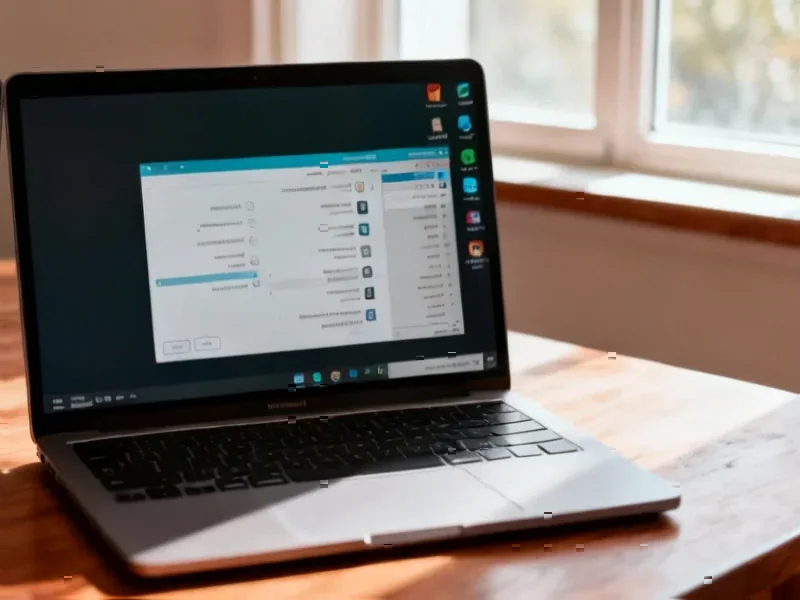According to Wccftech, Minisforum has launched the MS-R1, the first mini PC based on China’s Cixin P1 Arm processor developed by CIX Technology. The device features a 12-core heterogeneous CPU configuration built on a 6nm process node with performance cores clocked up to 2.6 GHz and includes an integrated Immortalis G720 GPU. First showcased at Computex this year, the MS-R1 stands out with its PCIe 4.0 x16 slot for discrete GPU expansion and offers memory configurations up to 64GB LPDDR5 at 5500 MT/s. The mini PC runs a custom Debian 12 OS and includes a dedicated NPU capable of 30 TOPS AI performance, though pricing and availability remain unannounced. This development signals a significant shift in the computing landscape.
China’s Computing Sovereignty Push Accelerates
The Cixin P1 processor represents more than just another Arm chip—it’s a strategic milestone in China’s decade-long push for technological self-sufficiency. While most attention has focused on China’s x86 alternatives like Zhaoxin, the Cixin P1 demonstrates that Chinese semiconductor designers are achieving competitive performance in the Arm space where they face fewer architectural licensing barriers. The 6nm manufacturing process, while not cutting-edge by global standards, shows meaningful progress in reducing dependency on foreign foundries. What’s particularly notable is that this isn’t just for domestic consumption—Minisforum is bringing this technology to international markets through established distribution channels, suggesting confidence in its competitiveness.
The PCIe x16 Slot Changes Everything
The inclusion of a full PCIe 4.0 x16 slot transforms this from a curiosity into a potentially serious workstation alternative. Most Arm devices to date have been either mobile-focused or limited to embedded applications, but proper GPU expansion opens up entirely new use cases. Developers working on Arm-native applications can now test with discrete graphics acceleration, while researchers can explore heterogeneous computing configurations that combine the P1’s NPU with traditional GPU compute. This moves Arm beyond the “good enough” computing paradigm into territory where it can genuinely compete with x86 systems for professional workloads, particularly in AI inference scenarios where the combination of NPU and discrete GPU could offer compelling performance-per-watt advantages.
The Real Battle Is Software, Not Silicon
Hardware specifications are only half the story—the success of platforms like the Cixin P1 will ultimately depend on software ecosystem development. The decision to ship with Debian 12 is strategically smart, leveraging the robust Arm support in mainstream Linux distributions while avoiding the Windows-on-Arm compatibility challenges that have hampered other entrants. For developers porting applications to Arm, having access to a affordable, expandable development platform with standard PCIe expansion could accelerate software readiness across the ecosystem. The real test will be whether Chinese software developers embrace this platform for creating Arm-native applications that can compete with their x86 counterparts in performance and features.
Shifting Computing Economics
This development arrives as the computing industry faces multiple inflection points—the AI revolution, supply chain diversification, and growing geopolitical tensions around semiconductor technology. The PC Watch report highlights that Minisforum is positioning this as a general computing device rather than a specialized product, suggesting they see broader market potential. If priced competitively, systems like the MS-R1 could disrupt the entry-level workstation and developer machine markets where power efficiency and total cost of ownership are increasingly important. The combination of Arm’s power efficiency with China’s manufacturing scale could create pricing pressure on traditional x86 systems, particularly in education, research, and development markets.
Where This Leads in 2024-2025
Looking forward, the success of platforms like the Cixin P1 will depend on several factors beyond raw performance. Software compatibility remains the biggest hurdle, but the growing containerization of applications and maturation of cross-platform development tools are lowering these barriers faster than many anticipate. We’re likely to see more Chinese semiconductor companies targeting the global Arm server and workstation markets now that the architectural and manufacturing capabilities are proving viable. The broader industry context suggests we’re entering a period of computing architecture diversification similar to the RISC vs CISC battles of the 1990s, but with AI acceleration as the new battleground. Within 24 months, I expect to see multiple Chinese Arm processors competing directly with established players in specific market segments where software compatibility is less critical.




